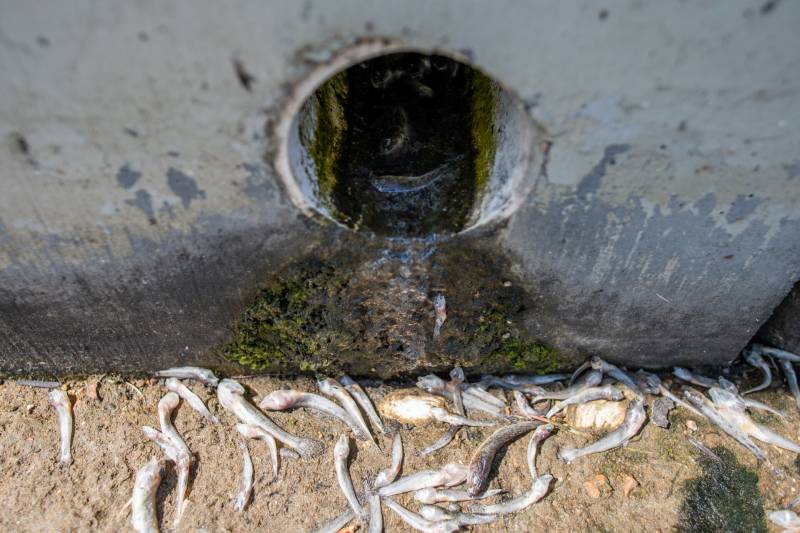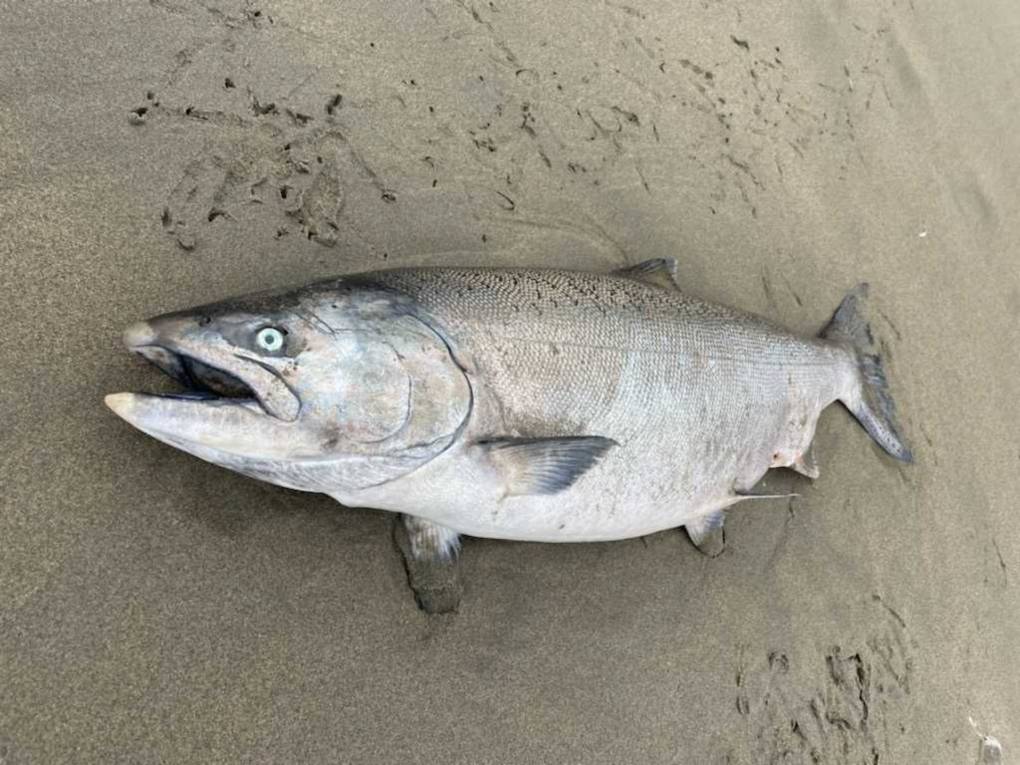Lake Merritt was particularly dramatic because it’s not very deep, so you can see everything. It’s really an uncountable number of fish.
We know that these fish have died as a result of an algal bloom. What is an algal bloom and how do they typically form? What has been so dangerous about this algal bloom in the bay?
A bloom is when the reproduction of a particular organism kind of goes out of control. And so that’s what’s happening here — a particular organism, heterosigma akashiwo, grew out of control. An algal bloom of any size can lead to low dissolved oxygen in the water as the algae die. Other things are consuming it in the water and their populations then go off the charts and they’re sucking the oxygen out of the water. And then fish don’t have enough oxygen.
Algae are a normal part of the bay. There are lots of organisms floating around in the bay that are the foundation of the food web for the bay. When one of those organisms starts growing out of control and we call that a bloom, once we get to a bloom state, then it can dramatically alter the chemistry of the water to the point that there’s no oxygen and/or lots of toxins floating around. It’s the size and the duration of this bloom that have caused the real problem.
Is it fair to say basically the fish couldn’t breathe?
We don’t know the specific mechanism that produced this fish kill, but it’s highly likely, and certainly the pictures that we saw indicate that these fish were struggling for oxygen, whether that’s because there wasn’t enough oxygen in the water or because the algae released a toxin that damages the fish’s gills. We don’t know. And it could be both.
What is your sense of the cause or causes behind this?
So, algae in any body of water need sunlight, nutrients and a certain level of water temperature. So San Francisco Bay, we know, is over-enriched with nutrients, nitrogen and phosphorus. The source of the nitrogen and phosphorus in the bay water is primarily from wastewater treatment plants around the bay. There’s 40 different publicly owned water treatment plants that are treating our wastewater. And after treatment, the effluent is disposed of in the bay.
When we say wastewater, we’re talking about sewage water, like human waste?
Treated sewage water. On average, that’s about a little bit over 60% of the nitrogen and phosphorus in the bay. Other inputs are stormwater runoff from urban areas and agricultural runoff, principally from the Central Valley. If you mix that over-enriched bay water with the right amount of sunlight and the right temperature, that sets the stage for harmful algal blooms like this to occur. We have those necessary conditions every summer.
My first instinct when I heard about this was to think about climate change. Did this happen because of climate change?
Everyone’s mind goes to climate change these days when there’s some sort of natural disaster. And that’s appropriate because the changing climate is certainly affecting everything. But we have no direct signal at this early stage of a particular climate change mechanism driving this bloom this year.
The important thing to understand is that the necessary conditions for a harmful algal bloom of this type are in the bay every year, and we’ve known that for decades. We don’t need to invoke climate change in order to explain what’s happened.
Again, climate change could have played a role and will likely exacerbate this problem, making it more common in the future. But, what we know is, there are nutrients in the bay that are always at a level that will support harmful algal blooms. The East Bay shoreline gets a lot of sunlight during the summer, and water temperatures reach levels that will support a bloom even before climate change. I’m not saying that climate change doesn’t have a role, but for some people, it’s convenient to point to climate change because it means that they didn’t have responsibility.
What is the problem and what is this really about, do you think?
One of the problems that’s not gotten enough attention is where our wastewater goes when we flush the toilet. I want to acknowledge again that there’s a smaller but measurable component of urban stormwater runoff and a measurable component from agricultural runoff. But we have wastewater treatment facilities that are operating the way they’re supposed to operate. They’re removing solids from the water. They’re treating the water and getting rid of the bacteria. But they’re not designed to remove these nutrients, nitrogen and phosphorus, before the water gets dumped into the bay. So it’s sort of an out-of-sight, out-of-mind problem.
This problem has been lurking for decades, and those who research it and study it and manage it within the agencies have been aware of it. This red tide, algal bloom, that we’re experiencing is a signal from nature that we’re taking too long.
In an interview with KQED, Bill Johnson with the San Francisco Bay Regional Water Quality Control Board said it’s actually too soon to say that human wastewater is to blame. Why has it taken so long, and why are these nutrients not removed from the wastewater?
It’s a challenging problem. To reduce that nutrient load is an expensive proposition. And so before we begin to make the investments, it’s prudent to know how much of an effect we need to have. That takes research. That research needs to be funded adequately in order to have it proceed at the fastest pace it can. And then there needs to be the leadership.
What are some of the things that you believe would help?
There’s technology to do wastewater recycling. Potable reuse. We can take the water that we flushed down the toilet or that goes down the drain, and clean it up to the level that people can use it, then we’ve removed the nutrients and we kind of have them in hand and we then have a choice of how to dispose of them. And hopefully, that choice would be to dispose of them in a responsible manner.
Other options in addition to water recycling would be nature-based solutions such as treatment, wetlands, constructed wetlands, wetland plants, and any plants like these same nutrients that the algae like. And they, well, they can soak it up and store it in their tissue, and then that’s treating the water as well. And then a final way would be continuing to invest in the large-scale restoration of the natural wetlands that used to surround San Francisco Bay. Natural marsh plants are also filtering this water that’s in the bay.
This sounds to me like infrastructure.
It’s physical infrastructure of the pipes and the filters and the systems to treat the water. It’s also natural infrastructure that unfortunately we’ve destroyed in the past, but are now turning towards restoring more.
What will it take to implement some of these solutions, and who needs to take the lead on it?
Various agencies are responsible, principally the Regional Water Quality Control Board, which issued permits for wastewater treatment facilities and stormwater runoff, etcetera. So there is sort of the lead agency at the state level. The federal level would be the Environmental Protection Agency. But also we have these sewage management districts, 40 treatment plants, and they have responsibility, too.
For instance, water recycling. As an example, San Francisco does not recycle very much of its water at all. But the San Francisco Public Utilities Commission could make the decision that they need to invest heavily in water recycling. So there’s many different actors that do play a role here and will have to play a role, and they will need a lot of money to implement these solutions.
What do you hope people take away from the events of this week?
I hope people take away from the fish kill the tremendous diversity and abundance of beautiful organisms that this bay supports, even though we don’t always see them. Many of the species that are going to be affected by this were already endangered or their populations have declined a bunch. And that’s because of the way that we treat this ecosystem.
San Francisco Bay is a gem and it’s a source of joy for all of us who see it. And when you drive over the bay and see that the water is blue and has returned to normal like that, that’s great. But it doesn’t mean that the problem has gone away or that we’ve solved anything. We really need to take this trauma and turn it into a focus on cleaning up our mess and living within the limits that nature prescribes.

